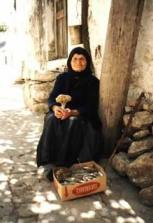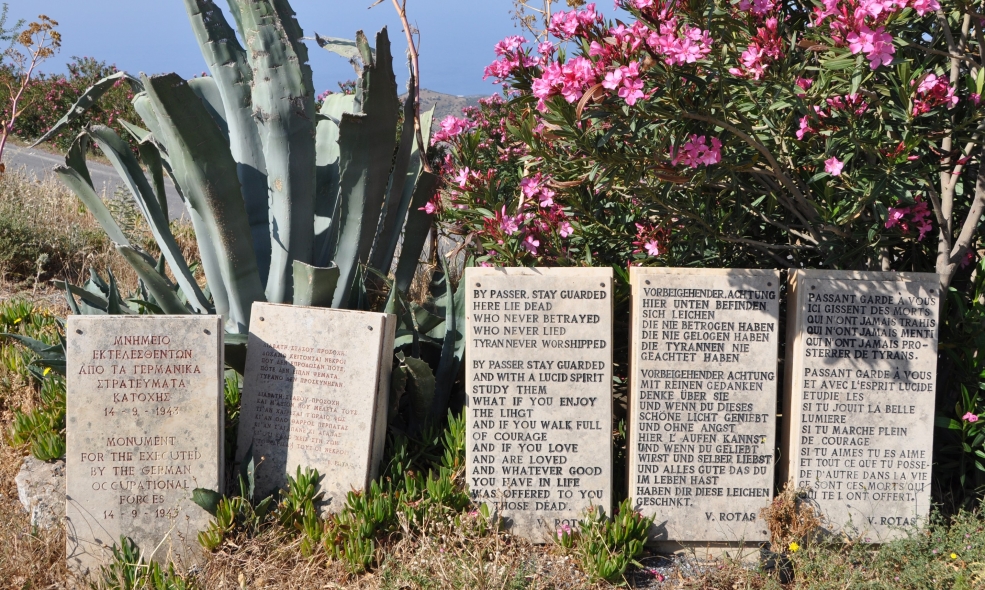What shall I send you, dear one,
There in the underworld?
If I send you an apple, it will rot,
If a quince, it will shrivel;
If I send grapes, they will fall away,
If a rose, it will droop.
So let me send my tears,
Bound in my handkerchief.
– Greek folk song
In previous essays I’ve written at length about the importance of rituals of grief in the tribal imagination, where the souls of the dead go neither to heaven nor to a nameless void, but to the Other World, or the Underworld.
…we may think of those souls as journeying first through a liminal period …between the worlds of the living and the dead. Liminal comes from the Greek word for threshold, which also gives us the word Limbo. We imagine those souls in a mysterious transition prior to rebirth into some new state of being. But the completion of the transformation, as in all initiations, requires the intercession of a greater community of beings who can facilitate the burial – both literal and symbolic – of the old before the appearance of the new.
Many myths reflect the belief that death is a process, rather than a single event in time. The dead require the focused acts of the living in order to complete their transition to the other world. But – of equal importance – the living need this process to succeed as well, because souls who wander in the liminal space between the worlds as ghosts will inevitably cause suffering for the living. The unburied dead in particular are condemned to haunt their relatives – those who should have performed the appropriate rites. Such souls are stuck, unable to conclude the last of life’s initiatory processes, the welcoming “home” by their ancestors in the other world. Like some mentally ill people in our world, they are “betwixt and between.”
In rural villages, archaic pagan customs still underlie a thin veneer of Christian belief. After a death, the community participates in ceremonies intended to serve the needs of the dead, to feed them, especially those who cannot enter Paradise without having had their sins forgiven.  Two coins are still laid on the eyes of the deceased to pay Charon, who has ferried the dead, pagan or Christian, across the river Styx since the very beginning.
Two coins are still laid on the eyes of the deceased to pay Charon, who has ferried the dead, pagan or Christian, across the river Styx since the very beginning.
Throughout these areas, we can still see aged crones  dressed completely and permanently in black, their heads always covered. After raising their children, their primary duty is to mourn the dead. Long after the funeral, the women sing daily laments at the grave. Anthropologist Loring Danforth notes the similarity of these chants to wedding songs, a reminder of the mythic “marriage with death.”
dressed completely and permanently in black, their heads always covered. After raising their children, their primary duty is to mourn the dead. Long after the funeral, the women sing daily laments at the grave. Anthropologist Loring Danforth notes the similarity of these chants to wedding songs, a reminder of the mythic “marriage with death.”
Unlike the Latin and Catholic world, where people welcome the temporary return of their dead on November 1st and 2nd, in the Greek (and Greek Orthodox) world there are up to seven “Saturdays of the Soul.”
Three to five years after a funeral, as professional mourners sing improvised dirges, close relatives of the deceased disinter the body.  They are searching for a sign. If the body has not completely decomposed down to white bones, this may mean that the soul is not yet at peace and may have become a wandering vampire or werewolf, a vrykolakas. The local priest may then determine that an exorcism is needed, after which the body will be carried three times around the church and then re-buried.
They are searching for a sign. If the body has not completely decomposed down to white bones, this may mean that the soul is not yet at peace and may have become a wandering vampire or werewolf, a vrykolakas. The local priest may then determine that an exorcism is needed, after which the body will be carried three times around the church and then re-buried.
After some years, if another disinterment reveals pure, white bones, the community agrees that the soul has been forgiven, has completed the transition through the liminal realms to Paradise and is at peace. Then, the family ritually deposits the bones (or perhaps only the skull) in the bone house or ossuary. In large villages, each family has its own ossuary, whereas in smaller villages there will be one ossuary for everyone.
The empty grave becomes available for another – temporary – resident. The period of liminality for both the souls and their relatives ends, and everyone can move on, free of the weight of both grief and responsibility. Except for the older women.
That’s the cultural background to a slightly fictionalized story I want to tell. But first, some historical background.
When Nazi Germany invaded the Soviet Union in 1941, Hitler decided that he needed to secure his southern flank. That simple strategy set in motion a ferocious invasion of Greece and the eventual death, mostly by starvation, of between 300,000 and 600,000 Greeks. Some historians have concluded that a tenth of the population perished.
The graveyards were so overfilled that many families had to bury their loved ones outside of the cemeteries in mass graves. This caused much additional distress, since many believed that those buried in unconsecrated ground became vrykolakas who would return to haunt the living.
Armed resistance in Greece, especially on the island of Crete, was the fiercest in all of occupied Europe, and it was met by the cruelest of reprisals in which the Germans massacred entire villages.
 Years ago, driving along the south coast of Crete, my wife and I stumbled upon a memorial in the Amiras area, where the Germans had destroyed over twenty villages and murdered some 350 people. My wife and I, two Jewish Americans, heard the only other people present speaking in German as they stared at the scene. Perhaps one of their parents had been there before.
Years ago, driving along the south coast of Crete, my wife and I stumbled upon a memorial in the Amiras area, where the Germans had destroyed over twenty villages and murdered some 350 people. My wife and I, two Jewish Americans, heard the only other people present speaking in German as they stared at the scene. Perhaps one of their parents had been there before.
Here is the story, written by Manolis Xexakis:
The Smile From the Abyss
Down in a glen I know there is a round ossuary where women come down and wash the heads of the deceased with wine on Saturday of the Souls. My mother has my grandfather there, and she visits him.
They bring the skulls down from the display cases, they carry them to the yard, and they lay them down on the side wall. The scene can give chills to an innocent passerby.
This whole business happens in the morning, the time when the day is lighting up and a murmur sprinkles through the olive trees, as do drops of sun.
It can pull your heartstrings to see the harmonious figures of living bodies plant themselves by the bare bones in that deserted place.
They go and pour wine in copper buckets and then, carefully, softly, without dipping their fingers in the black holes, baptize the skulls for a long time and “caress” them. They say, “My ill-fated one, my unfairly killed one, once upon a time you were a human being too…”, and as the sun rises for good, the priest arrives and reads the prayers over a plate of memorial wheat, and as soon as he is finished the women talk among themselves about those who have left but are still present. By noon, they all leave the cenotaph and the area withers completely.
From stories, I hear that my grandfather was shot in his eighties.
The Germans surrounded the village and rounded the people up. They brought them down to a ravine with their hoes on their shoulders, and the interpreters kept telling them that they would be transported to the airport at Tymbaki for work. The captives spent hours in anticipation. The wind was blowing with sudden swirls, then it would disappear.
The procession of the morning frost was passing before their eyes. They had been arrested in retaliation for someone in the village who had disinterred two dead Germans so he could take their boots and clothes.
The Germans separated the women out. They arranged the men in a line. They made them dig the graves. A few shots were heard from a machine gun, and then the dull finishing shot.
Later the women went as far as the ravine to the open graves, where they cleaned the bodies of the dead and covered the ditches, without a cross or writing or any special sign.
After three years they each identified the heads of those shot by the final gunshot hole in the skull.
But even now there is one skull that three women claim and they do not know exactly to which of the dead it belongs. So on Saturday of the Souls all three wash and clean the skull together, and each believes that it is her loved one.
Well, in this treacherous world there are dead who belong to all of us, and we must all claim them. Otherwise, souls are stuck in the thorns and human deeds blown away by the wind.
But the mystery – and necessity – of grief and remembrance in Greece does not end here. Having sustained very heavy losses in the invasion and occupation, the Germans established several cemeteries there for their own dead. The people of Crete still oversee and tend these places, where a custodian says:
At dusk you can often see a poignant sight; black-dressed old Cretan women lighting candles on the graves of past adversaries.
When you ask them why, they reply, “They, too, have a mother, and she is far away or dead. We also lost our sons…We know how a mother feels. Now, we are their mothers.
Now that’s the way to run a culture.
For further Reading:
Danforth, L.M. The Death Rituals of Rural Greece.
Fermor, Patrick Leigh and Roderick Bailey. Abducting a General: The Kreipe Operation in Crete
Garland, Robert. The Greek Way of Death.
Huntington, Richard and Metcalf, Peter. Celebrations of Death – The Anthropology of Mortuary Ritual.
Markale, Jean. The Pagan Mysteries of Halloween.
Prechtel, Martin. Long Life, Honey in The Heart
Pschoundakis , George. The Cretan Runner: His Story of the German Occupation
Shay, Jonathan. Achilles In Vietnam.
Some´, Malidoma. Ritual: Power, Healing and Community.
Some´, Malidoma. The Healing Wisdom of Africa.
